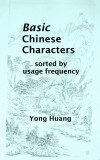Basic Chinese Characters
sorted by usage frequency
Basic Chinese Characters contains 2500 commonly used Chinese characters. The book sorts the characters by usage frequency. A learner may choose a certain point in the book suitable to his or her level and start to learn the characters. The book is a good way to learn or review Chinese characters in a casual way and on a cell phone.
Cover

Sample Pages
- Sample pages 1, 2, 3, 4, 5. (Pinyin tones are marked by numbers 1 through 4; abbreviation w.p. means "when pronounced".)
-
Notes Abbreviations, notes on pinyin, character frequency, definitions, etc.
Issues
The Chinese characters may appear in suboptimal font when viewed in Kindle for PC. The problem does not exist when viewed on a cell phone or in Kindle Cloud Reader.
Contact
Please contact me by email to yong321@yahoo.com or by filling the form with comments or corrections.
Availability
Download The link is a PDF file (updated Feb 3, 2024). If you want the Word document instead, please contact me. It has the clickable Table of Contents, which allows you to jump to a specific word frequency range.
Amazon Amazon has no option to set the price to zero. But I regularly "promote" the book and it becomes free during the promotion period.
Q & A
Why are the characters not ordered by pinyin or number of strokes?
Since the book is not strictly a dictionary and is meant to be a study material, I thought ordering the characters by usage frequency would make more sense because the reader can go to a section that matches his/her level and start to read.
Is the book free?
From this website, yes, it is. On Amazon, it is not because it's not allowed. But I "promote" the book frequently. During a promotion period, the book is free. If it's not free when you see it, let me know.
How are the characters selected and sorted?
The 2500 characters are called basic or frequently used characters according to the Ministry of Education of China. (Their website keeps changing links. Currently the table of the basic characters can be found on a non-government website.) They are sorted by usage frequency according to Google's estimate of occurrences on the Internet (details).
Any suggestion on efficiently learning Chinese characters?
I have no reservation in recommending two books whose authors I have absolutely no connection with. Alison Matthews, Laurence Matthews, Tuttle Learning Chinese Characters, and Rick Harbaugh, Chinese Characters: A Genealogy and Dictionary. An adult learning the vocabulary of a foreign language, or characters in case of Chinese, must to some extent rely on mnemonics and/or etymology. These two books are the best I know in offering these two pieces of information to an English-speaking person. The rest of the study is the same for a learner of any age, i.e., repeated drills. And the more the better. In this regard, my book, which is easy to load in a cell phone to be reviewed at any short moment, maximizes the occurrences of these drills.
What's the background picture on the cover of the book?
That's my hand-copying (临摹,lin2mo2,línmó) of the Qing dynasty painter Huang Ding's Shan Shui Tu (山水图,Picture of Mountains and Water). I have a full page dedicated to this painting with some other comments.
Yong Huang
June 2018 —
To my Miscellaneous Page
